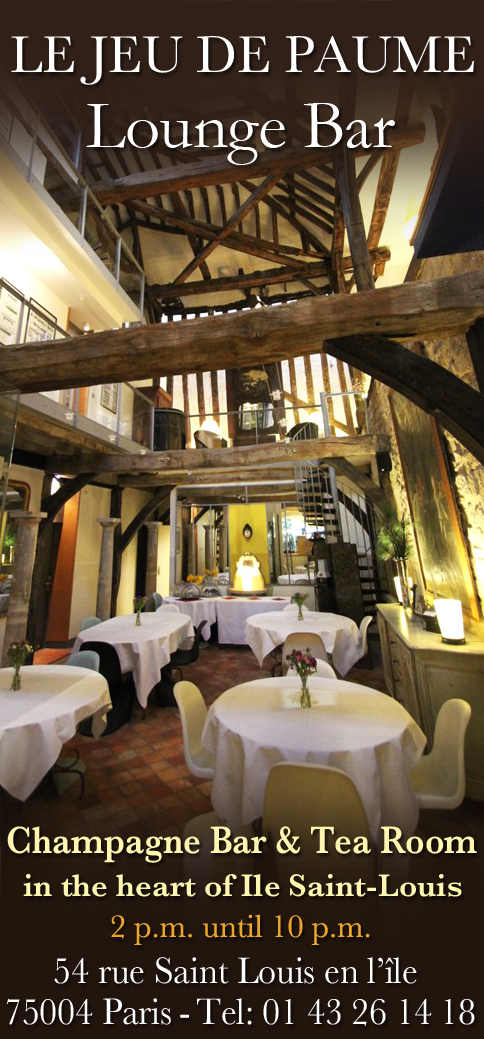 The angels in le Marais
The angels in le Marais
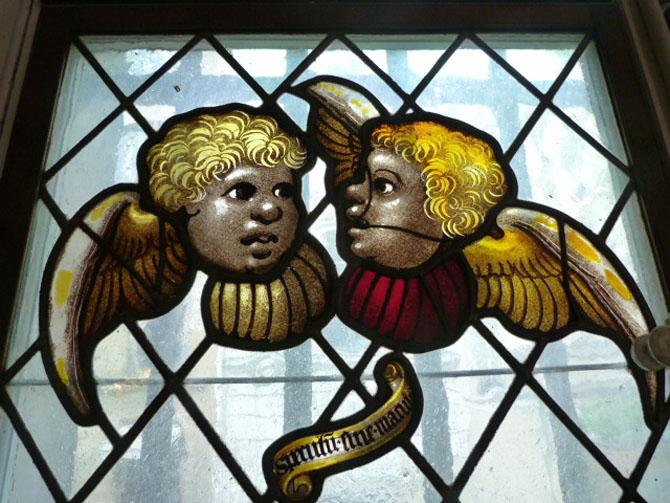
Hotel Liberal Bruant
1 rue de la Perle, 3rd arrondissement
The Architect’s Angels
Dancing on the pediment of a luxurious city mansion in the heart of the Marais, two little boy angels drape garlands of flowers around the oculus – the round window – as fruits, flowers and foliage tumble from giant cornucopia at their feet. It was a time of luxury and splendor under the Sun King, Louis XIV, and the intricate, abundant low-relief sculpture is redolent of its time.
The hotel particular, or private home, was the property of architect Liberal Bruand, an exceptionally gifted man who had been appointed as architect to the king at the age of 28, having proved himself on projects such as the chapel of the Salpetriere Hospital and the Basilica of Notre Dame des Victoires. A master of French classical style, Bruand was an advocate of a streamlined, uncluttered architecture concerned with solidity, utility, and mathematical harmony.
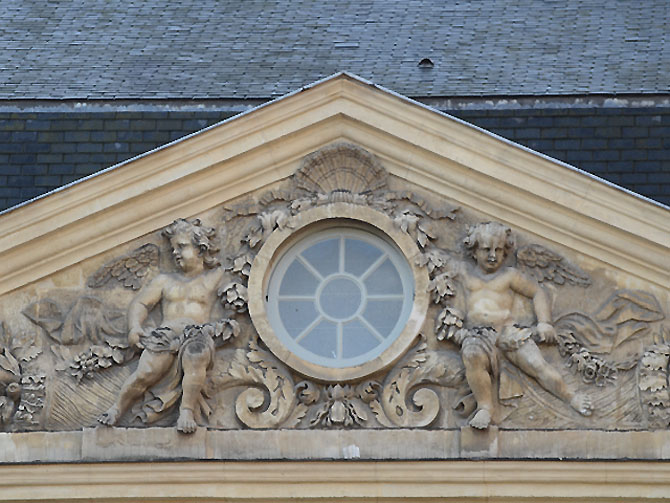
The most famous of his works is the Invalides, built from 1670 to 1674 to house aged and invalided soldiers. Bruand used the frontage of the Invalides’ Honor Courtyard (Cour d’Honneur) as a template for his own home, adapting design details such as the unusually long and lavishly ornamented pediment spread across the central corps of the building. For the Invalides, it would be adorned with armored knights; here, it is winged cherubs with floating drapery and thick locks flying in the wind.
Bruand’s mansion was built in 1685, a time when classical architecture began to take on a lighter, baroque turn; a whiff of unruly passion perturbs orderly reason. The little angels, by an unknown ornamentalist sculptor, are a charming visual caprice and a frivolous departure from sober stability.
Today a private residence, it is hidden from view by a large wall that surrounds the inner courtyard. The beautiful angels bring a joyful touch to the neighborhood.
The Angels of the Hotel de Soubise
Hotel de Soubise - 60 rue des Francs-Bourgeois, 3rd
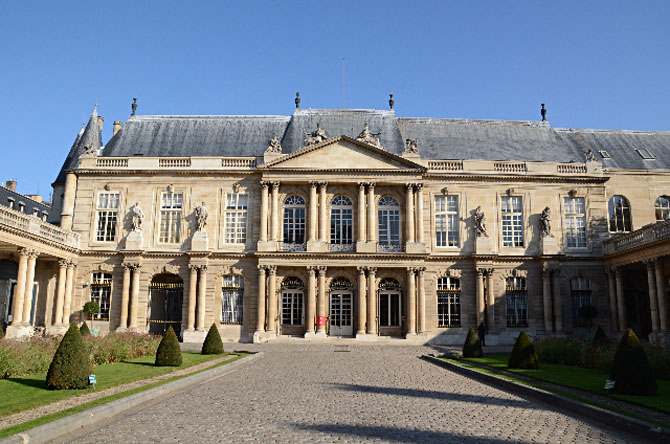
Perched on corner pediments of one of the most beautiful mansions in Paris, copies of Robert Le Lorrain’s endearing winged cherubs add a whimsical touch to its classical facade.
Le Lorrain had set up his studio in the nearby rue de Meslay soon after returning from Rome, where his outstanding talent had won him six years pension at the Palazzo Mancini to study works from antiquity and the Renaissance, and to create. Le Lorrain’s stay was curtailed by a chest ailment - common to sculptors, in constant contact with stone and marble dust – but once back in Paris, commissions for statues of angels, saints, and mythological figures poured in for cathedrals, churches and the chateau of Versailles.
The Hotel de Soubise angels, with their lively and varied poses creating a dramatic play of light and shadow, express the new Baroque style that Le Lorrain had mastered in Italy. They were executed circa 1708, when the mansion, formerly the 16th century Hotel de Clisson, was being entirely remodeled for the beautiful princess Anne de Rohan-Chabot by architect Pierre-Alexis Delamair.
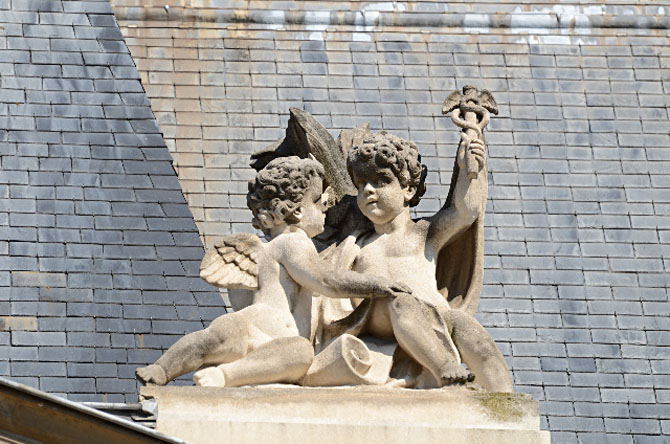
The angel on the left props up fringed standard flags and unscrolls a banner engraved with Medusa’s head, while his dirty-faced companion sits, grasping a sword: all military accoutrements appropriate to the station of Francois de Rohan, prince de Soubise and lieutenant general of the royal armies. On the right, a corresponding duo is set in front of a sheaf of leaves. An angelic tyke leans forward in a sinuous pose as his partner raises the caduceus, Mercury’s emblem signifying commerce and negotiation; references, perhaps, to the prince’s other offices as governor of Champagne, of Berry and of Brie.
Francois de Rohan had already acquired the Hotel de Guise, just around the corner on the present rue des Archives, in 1697. His wife, Anne de Rohan-Chabot, lady in waiting at the court of Versailles, had caught the eye of Louis XIV; it was said that the new house did not cost her husband much because ‘the king had provided the wood (the horns of the cuckolded Soubise) and his friends supplied the stones’ (which they threw at him, figuratively speaking).
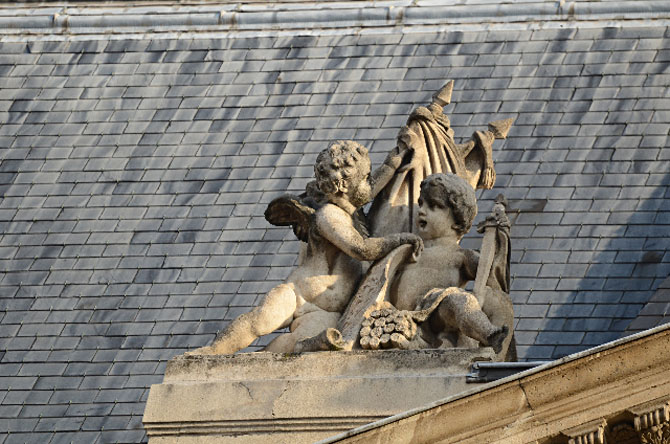
No expense was spared in the design, with its splendid courtyard bordered by colonnaded porticos and a vast garden in the back of the property. The façade’s sober, classical symmetry is lavishly decorated with more sculptures by Le Lorrain: cherubs hold attributes of the arts and sciences on rooftop corners; seated female figures lounging on the pediment’s slope personify Glory and Magnificence; and allegories for the four seasons adorn the first story.
Since a Napoleonic decree of 1808, the mansion became state property. Today it is the seat of the national archives and hosts exhibition rooms for the Musée de l’Histoire de France.
The Angel of Death
Hotel de la Mercy-45 rue des Archives, 3rd arrondissement
The Angel of Death hovers high over a sundial on the western wall of a property once used by the Order of Mercy, a Roman Catholic order founded in 1218 during the time of the first Crusades. A small community of men dedicated themselves to sacrificing their lives and worldly goods for the ransom of impoverished Christians held as slaves by Moslems. Marie de Medicis granted the priests permission to set up quarters in this former convent in the Marais district in 1613. Under Francis I, it became an Augustinian monastic order.
It was shut down during the French Revolution and transformed into a prison, to hold those awaiting sentencing under la Terreur, when thousands met an untimely death at the guillotine.
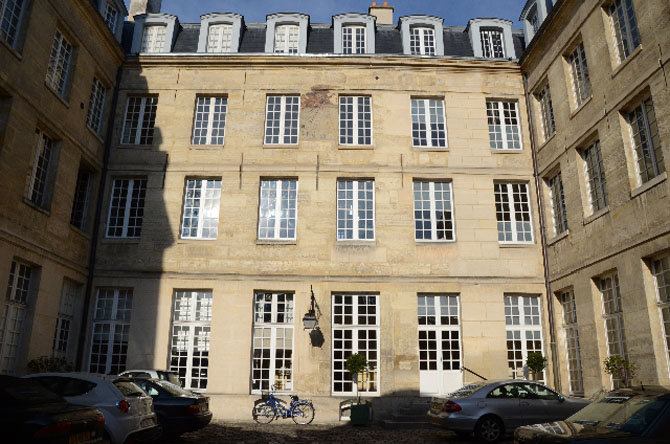
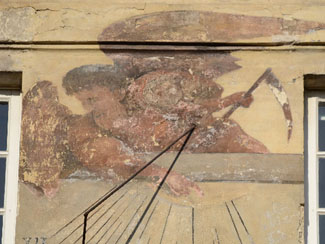
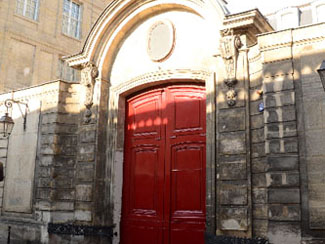
One can only imagine the thoughts of the condemned, counting their mortal hours while contemplating the depiction of this cruel, aged angel, an allegory for Time. He points ominously to the first hour in a macabre reminder of the transience of life while his raised left wing shadows the dark profile of the grim reaper stealing away furtively, bearing a scythe – a symbol of the severing and harvesting of human souls. The Angel of Death carries on, scoping the world below for his latest prey.
The astounding 17th century sundial painting is a fresco, a word derived from the Latin word for fresh. Colored pigments mixed with water are applied to a thin layer of fresh lime mortar plaster. The technique dates to Antiquity and allows for the creation of paintings, such as this, which can last for centuries.

The Angels of Paris : interview with Rosemary Flannery
I am thrilled to announce the launch of the book The Angels of Paris: An Architectural Tour through the History of Paris by Rosemary Flannery. Today is an interview with Rosemary about this must-have book for anyone who loves the architecture and history of Paris along with ravishing photos.
How Did You Come Up With The Idea For The Angels Of Paris?
I used to go jogging in the Parc Montsouris and would see this giant angel on top of a column, just at the entrance to the park. It seemed so welcoming and protective, I loved the way it seemed to greet me each morning. Later, I began to notice angels all over Paris, adorning not just churches but on sundials, atop theatres, over doorways and in all sorts of unexpected and unusual places. I originally thought of doing a series of cards illustrated with photos of angels but became curious about the history behind each angel, and who created them, and why they were there. The way that the angels reflect the various art movements from the Gothic, through the Renaisssance, baroque and rococo periods up to Art Nouveau and Art Deco styles is also quite fascinating.
On What Basis Did You Select The Angels?
I selected them in particular if they were beautiful or curious or unusual, or if they had an interesting story to tell. I also wanted to have an angel – at least one – for each arrondissement. The older districts such as the Marais, and the 5th and 6th have the most angels, but the later arrondissments often have only one or two. I was determined to find at least one for each area.
Which Was The Most Surprising?
It’s hard to say, so many of them are amazing. I guess it would be the angel of the rue de Turbigo - he’s immense, a giant angel spanning three floors of the façade of a residential building. The head of the Nagasaki angel, a vestige of a church bombed in 1945, was later offered as a gift to the UNESCO Peace Garden. It is very poignant and surprising because it survived and is now in Paris.
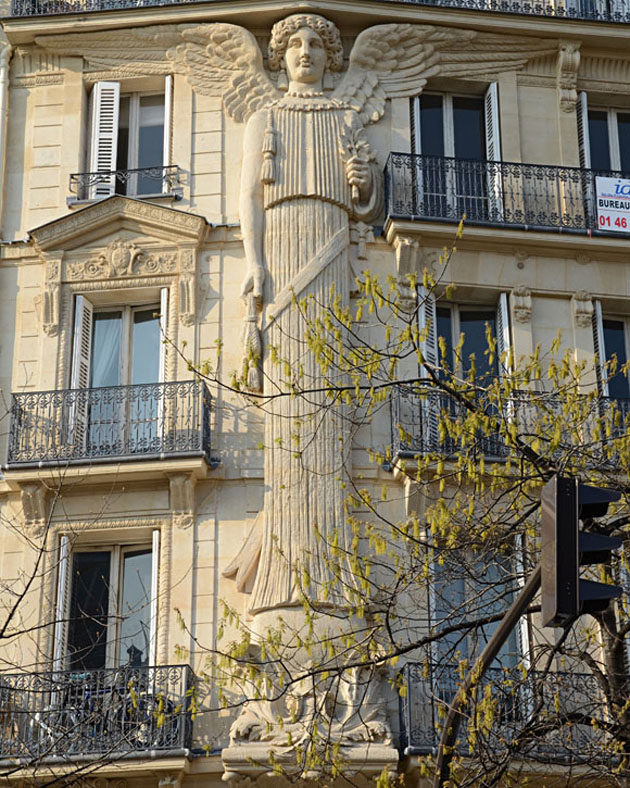
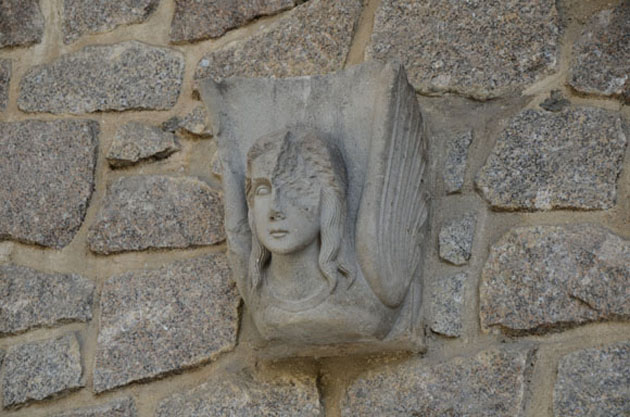
How Many Angels Did You Start With Originally And How Did You Choose The Ones That Made It Into The Book?
I started with about 30 angels, which quickly grew to about 90 or so. The book has 70 angels; I chose the most interesting ones with the most intriguing stories.
You Wrote And Took All The Photos, Which Is Quite An Accomplishment. Did The Writing Inform Or Influence The Photographs Or Vice Versa?
The photos serve to illustrate the writing. I tried to take pictures which would best tell the particular story or show the idiosyncrasy – the personality! - of each angel.
What Was The Most Rewarding Part And The Most Frustrating Part Of Your Research?
Doing research is like going on a treasure hunt or being a detective. It’s fascinating; even if you don’t always find what you’re looking for, you inevitably find something else along the way. The most rewarding was finding a copy of a 1665 engraving, which showed angel carvings over the side door of the St. Nicolas du Chardonnet Church in the 5th. These angels originally held a cross and a crosier, which zealous Revolutionaries replaced with pikes in 1792! They were recruited into the revolutionary army. . . The most frustrating part was seeing a gorgeous little angel carved in wood, above a doorway on the avenue de l’Opera, and not being able to write about it, because absolutely no information exists about the construction of the building, or who the architect or sculptor were.
I Would Think That Each Angel Is Like One Of Your Children And You Love Them The Same But Is There An Angel Or Two That Is Close To Your Heart Or Resonated With You In A Deep Way?
The medieval angels from Notre Dame and from the house of Nicolas Flamel. There is such variety, humor, pathos and fine design in each of them. They are beautifully sculpted with such intricate details, and they seem very humanistic.
If You Could Invite One Angel Over For Dinner, Who Would It Be, What Would You Make, And What Would The Conversation Be?
The angel playing the mandolin from the 1407 house of Nicolas Flamel. The conversation would be all about the Marais during the Middle Ages, and whether or not Flamel – reputed to be an alchemist – really was. The angel could tell me about the characters who frequented the house, which had – and still has – an auberge on the ground floor. Flamel was a great entrepreneur; he was a jurist and a copyist, he illuminated manuscripts, had a bookstore, and taught the art of the illuminated manuscripts at his school. It’s believed he designed his own tombstone, and most likely made the drawings for the four angel musicians engraved in stone, flanking the entrance to the house. This particular angel looks like he has a great sense of humor, so I think the dinner would really be a lot of fun. Maybe he’d play us a few melodies? Not sure that angels eat and drink, but if so I’d probably serve him my famous soufflé au fromage with some mead wine. Table would be dressed with roses from the rue des Rosiers, and for dessert, maybe some macarons to bring him into the 21st century!
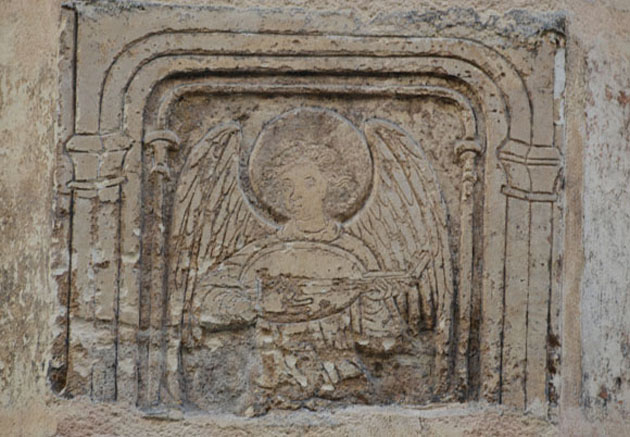
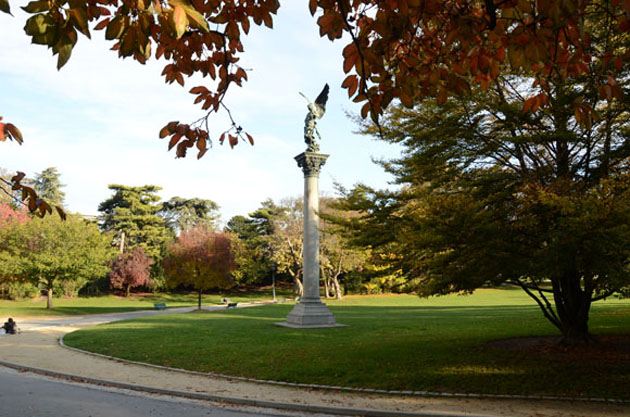
.jpg)
The Angels of Paris is available on AMAZON.
Click here to order
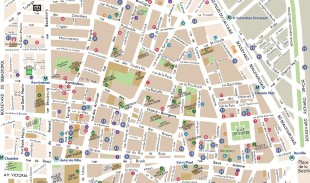
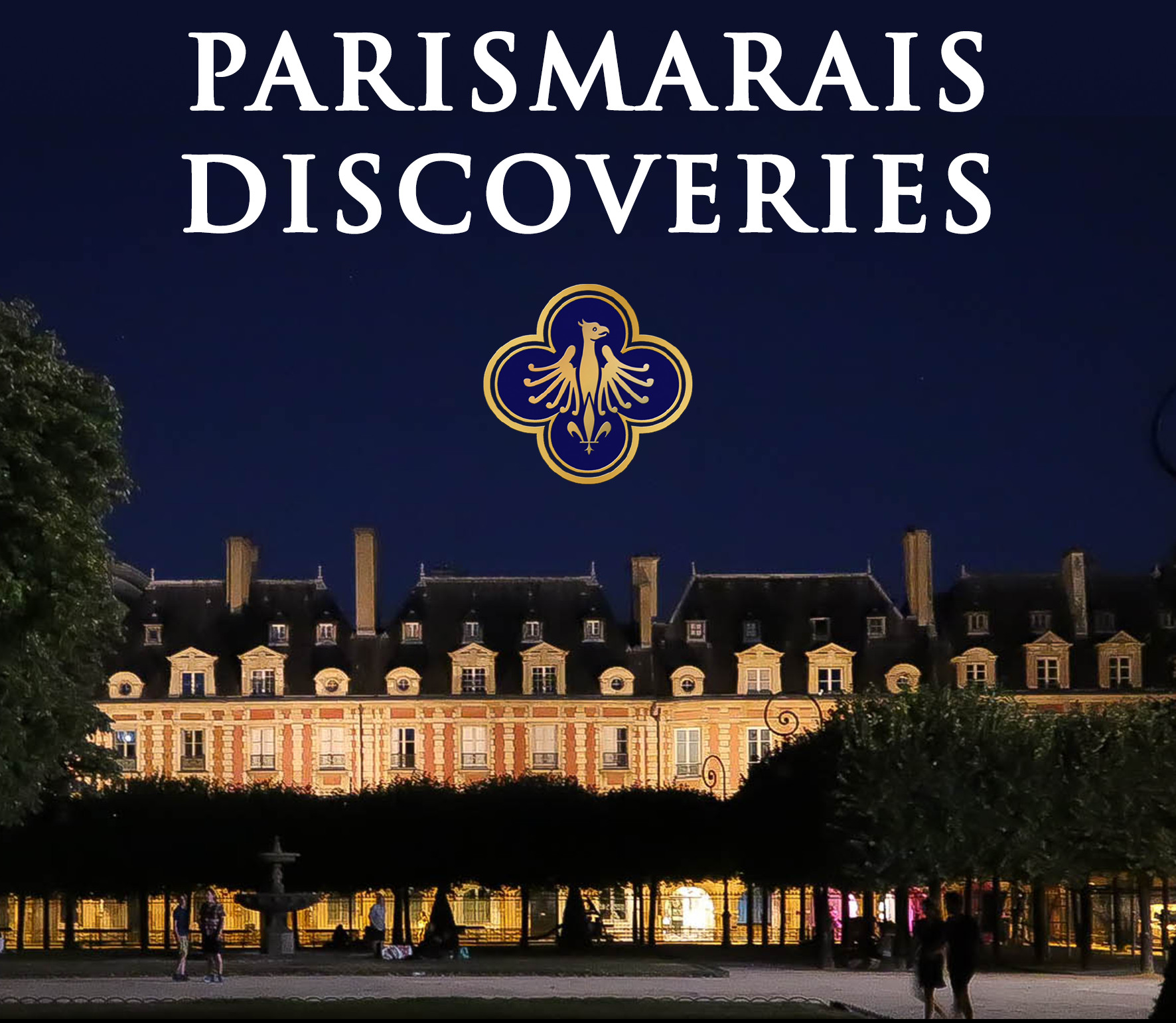
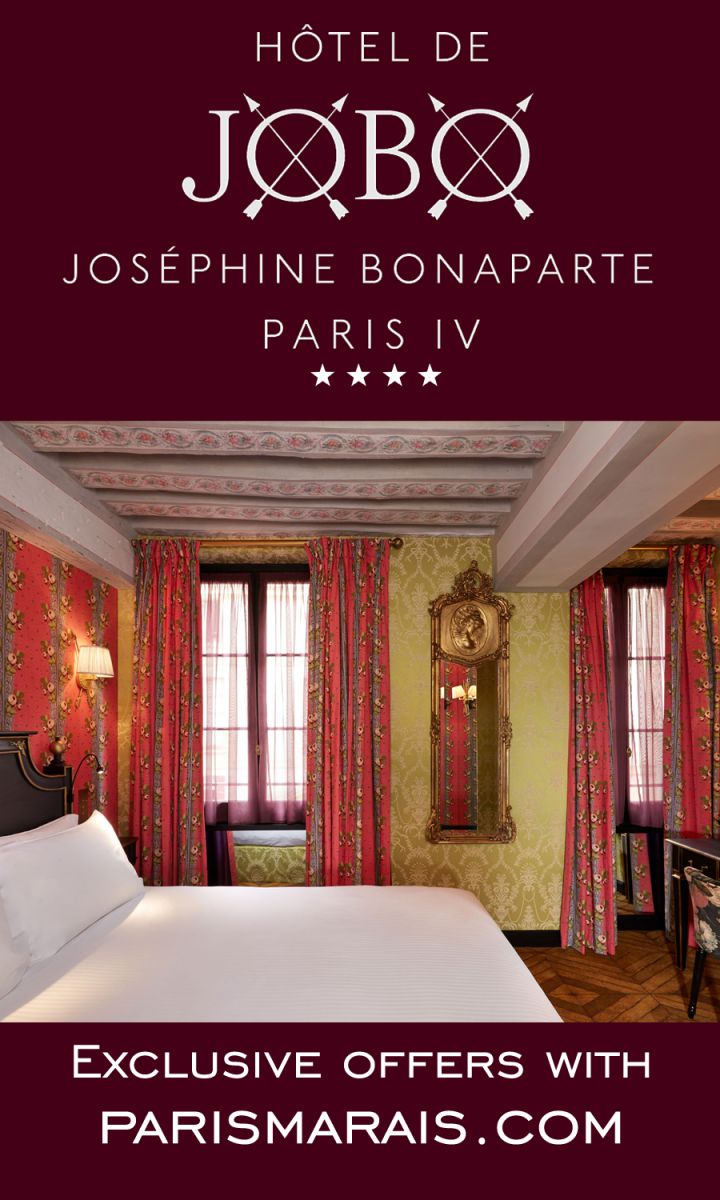
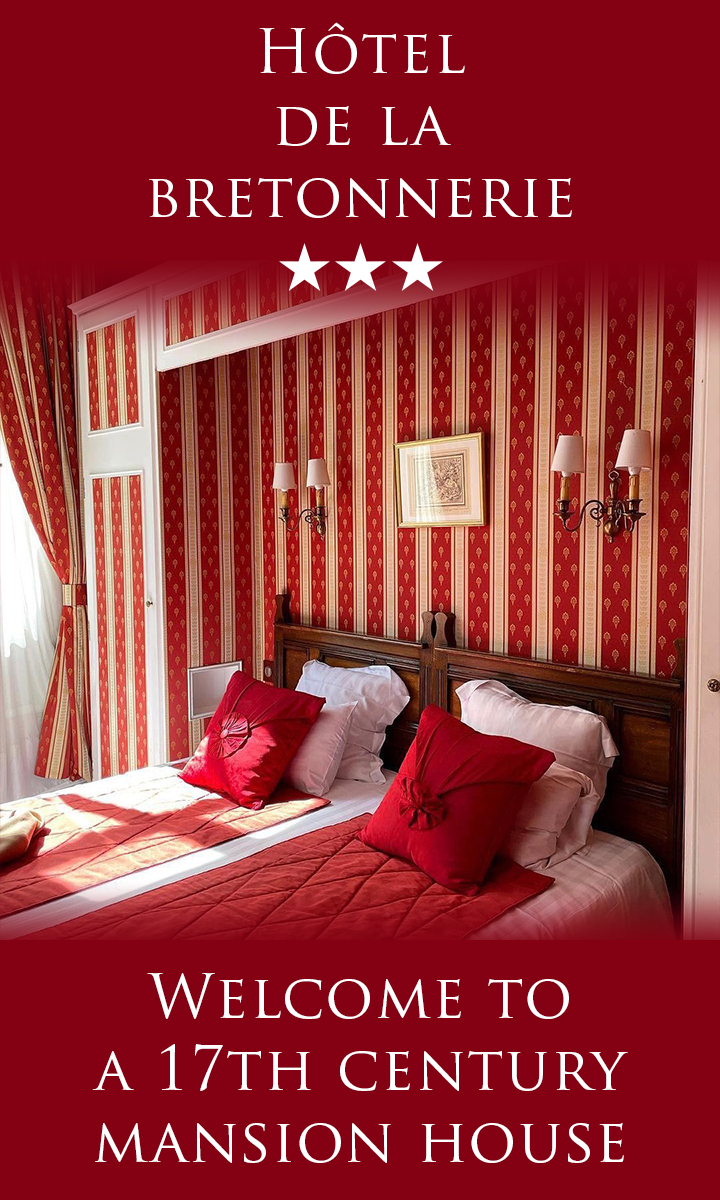
.jpg)
